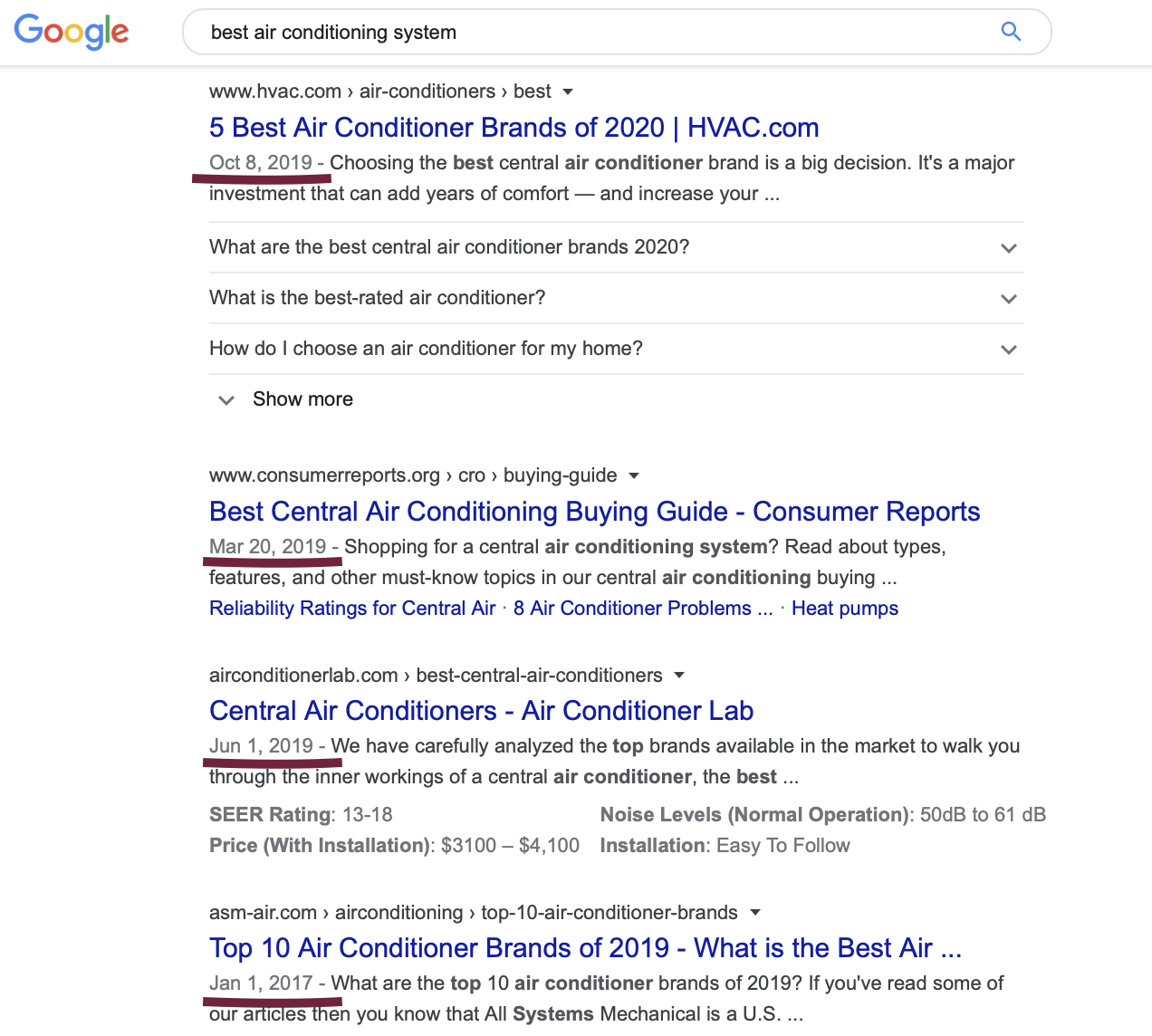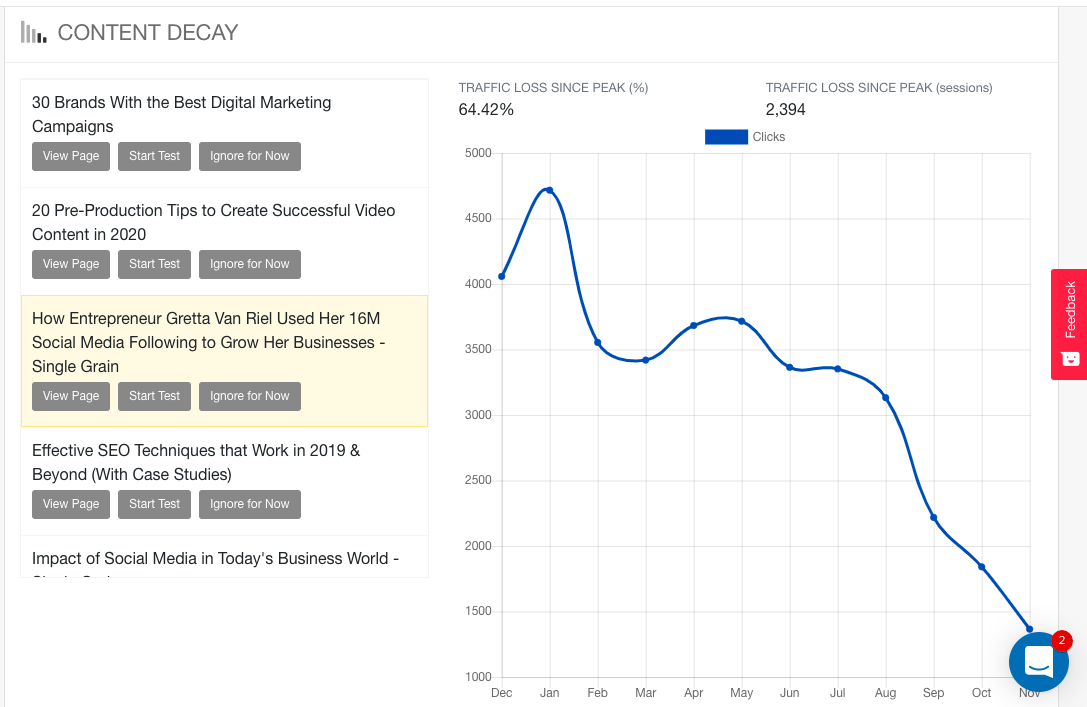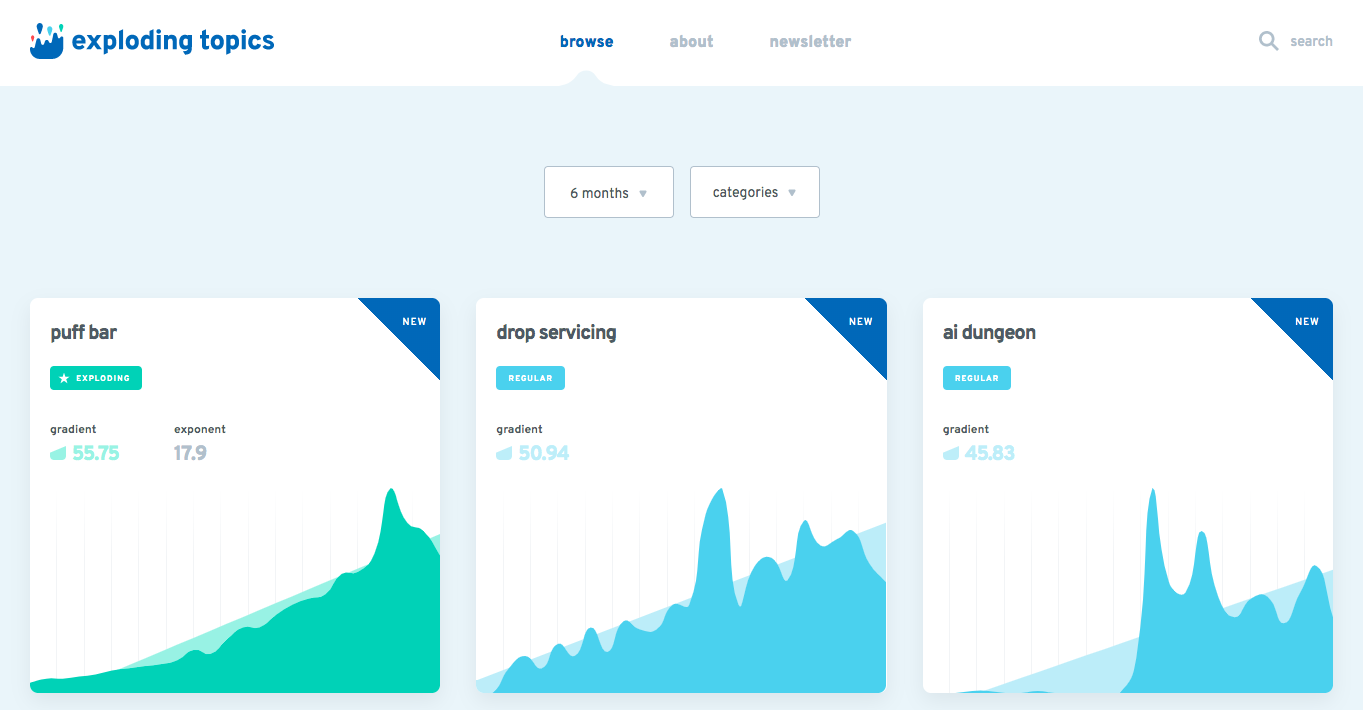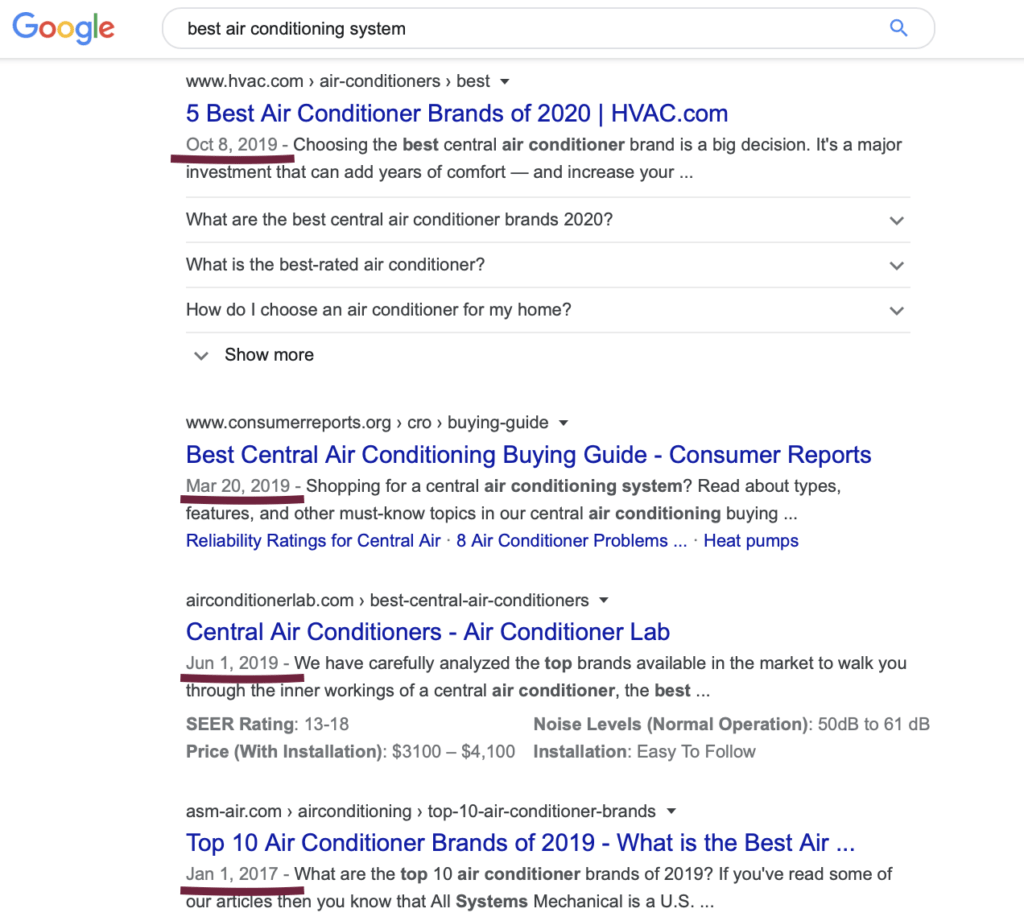HEADS UP: If you’re looking to boost your SEO traffic quickly, an easy way is by updating old content. Try our FREE tool, Content Decay, to check if you’re losing traffic due to declining pages (so you can refresh those posts and win back that SEO juice!). Click here to get Content Decay for FREE.
There’s one semi-tragic experience that every online blog will inevitably experience at some point.
Has this ever happened to you:
You’ve worked tirelessly to create a strong, best-in-the-industry blog post. It’s chock-full of case studies, examples, rich media and statistics, and it was carefully written and edited to be both entertaining and actionable. It’s an enormous thrill to see that blog post rank in the number one spot in the SERPs – and then it’s heartbreaking to watch it suddenly start to fall in ranking.
If you search for almost any keyword, there’s a solid chance that today’s number one ranking result won’t hold that position after a few months.
With more than 4.4 million blog posts published every day, it’s easy to get discouraged about ever keeping a top position in the SERPs – and it can be if you’re not combatting content decay.
What Exactly Is Content Decay & What Causes It?
Content decay is, simply put, content that’s been declining in traffic over the past twelve months.
In many cases, this can be directly tied to a decreased ranking in the SERPs, which unfortunately happens naturally over time.
There are a number of reasons why content decay happens, including the following:
- Brands are typically focused on moving forward, not looking back. They prioritize new content, and as a result stop promoting past content on social media, in email newsletters, and in ad campaigns. This results in a direct loss of incoming traffic.
- Google prioritizes newer content. Google loves relevant, fresh content that is up to date with the most recent information. Google monitors three types of searches when it comes to “fresh content”: regularly occurring events, frequent updates, and hot topics and recent events. If you’re not publishing new content, this can result in even the best resources potentially falling in the SERPs over time.
- New competitors may emerge and snag your top SERP spot. Unfortunately, it’s not uncommon for competing blogs to use the “skyscraper method” in which another writer essentially takes your top-performing content, adds to it to make it much better, and tries to usurp your ranking.
Related Content: What You Should Do With Old Content That’s Not Getting Traffic
How Content Decay Impacts Your SEO
Content decay naturally takes a negative hit on your SEO efforts, which in turn results in less traffic coming to your site.
This can result in a downward spiral if you don’t take steps to correct it soon. As fewer people click on to your article because of a lack of visibility, your ranking will fall more and more, and at some point it becomes harder to rank well again.
All else being equal, Google prioritizes fresher content.
This is frustrating, because after all the time and effort you put into carefully creating and optimizing your blog post, it can eventually have a diminishing value of return. If you don’t take efforts to refresh your content (which we’ll show you how to do in just a minute!), content decay and its negative effect on your SEO strategy are almost inevitable.
Take a look at this example that demonstrates that Google prioritizes recency. You can see that the first three results are from last year:

Your ranking will fall as content decay sets in, no matter where you are in the SERPs and even if your brand consistently ranks well in the search engines.
Keep in mind that even a drop from the second spot down to the ninth can be devastating for potential clicks and conversions on your site. This is particularly true considering that 57% of B2B marketers have named SEO as their most powerful lead generator, and 72% have named content marketing as their most effective SEO tactic.
How to Spot Content Decay on Your Site
There are a few tools and strategies that you can use to spot content decay on your website.
Content Decay by ClickFlow
Content Decay is a feature designed specifically to identify content decay in our SEO experimentation tool ClickFlow (full disclosure: this is our tool). It connects to your Google Search Console account and automatically finds and flags posts that have been declining in traffic over the past year:

With this tool, you’re able to see exactly how traffic has fluctuated for each post affected by decay. For each page, it shows you the three months before and three months after a decay was detected so you can discover any patterns.
Knowing exactly which posts have been getting less click-throughs will help you increase your organic CTR opportunities.
Although we’re obviously biased towards our own tool, there are other tools that you can use, though they may have some downsides.
Google Analytics
Use Google Analytics to carefully watch your blog posts and keep an eye out for changes in the overall traffic coming to them. If there’s a consistent decline in traffic (as shown in the below image), you’re experiencing content decay:

The downside to this approach is that it’s a very manual approach and it can take a lot of time on a regular basis. You need to track each post year-over-year, and that’s not always easy or efficient.
SEMrush
Another approach is to use a position-tracking tool, like the one available through SEMrush. This will alert you when any of your tracked pages increase or decrease in ranking in the SERPs. This can be useful to detect SEO changes that could result in or be caused by content decay.

It doesn’t tell the full story, but it’s useful for flagging decay so you can address it quickly.
Try our FREE tool, Content Decay, to check if you’re losing traffic due to declining pages (so you can refresh those posts and win back that SEO juice!). Click here to start using Content Decay.
How to Grow Your SEO Traffic by Fixing Your Content Decay
If you’re starting to wonder if content marketing is even worth it when you factor in content decay, don’t worry, it absolutely is!
There are plenty of case studies that prove this fact, including this one that details how the brand Capgemini used content marketing to attract:
- more than one million new visitors to their site
- and 1.8 million shares of their content
While blog posts can’t just be written, optimized and put out into the world with full finality, there is some great news here: With the right strategy, you can refresh your posts and re-optimize them so that they can gain that “fresh” perspective, outrank your competition, and get you the results they were delivering before.
At a minimum, we recommend refreshing (and expanding on) the pages that have shown content decay.
Here are some quick, actionable ideas to guide your refreshes which, in many cases, is enough to win back SEO traffic:
- Expand the word count and add more depth and examples
- Replace outdated stats and references that “date” the post
- Re-promote this updated content to your email list and on social
- Add internal links from other posts to these pages
Now, let’s take a deeper look at how you can fix your content decay and get back that SEO juice:
Expand Past Blog Posts
Content refreshing is a common content marketing strategy.
When you’re updating old content, you get the chance to expand the word count and add more depth and examples to it. Not only does this make your post more valuable overall, it also triggers that “new” factor that Google loves so much. This can help you gain some SEO points back.
Take a look at any older posts that have recent declines in traffic. A great practice is to read through and consider what else you naturally want to add. A lot of our older content is still good, but just really short (500-800 words). These are prime examples that can use a simple expansion.
You can also look at questions that users have asked in the comments section of the blog post or on your social shares to get an idea of what additional information could be valuable.
Note: When you’re updating old posts, make sure that you’re keeping the same original URL. While Google does like new updates, using some of that “SEO juice” you’ve already got is a powerful combination.
Dive Deeper: How to Build a High-Performance Content Marketing Strategy
Update Past Posts with New, Relevant Information
Sometimes, your best bet is to take a look at older posts and see if the information in them simply isn’t relevant anymore.
Maybe all your studies are out of date (beyond three years old) or maybe there have been industry changes that have made your post outdated or even incorrect. Perhaps a new technique or piece of technology or official Google update has come out since then.
If it’s been a couple years since you wrote the post, chances are the info that needs to be brought up-to-date is usually fairly obvious (“Say, have you heard about this new thing called Facebook??”). Also, be sure to remove or update any references to the current year (that, three or four years later, is no longer current).
To help you figure out how to really revamp an older blog post, you can use the skyscraper method, which, simply put, involves:
- Finding link-worthy content
- Creating something better
- Sharing what you’ve written
This means reviewing the top-performing content for the keyword that you’ve optimized for and see what’s ranking on the first page of the SERPs.
Take a look at what they discuss and make note of any additional content they’re lacking that you could add to your post. You never, ever want to plagiarize, but getting a little bit of inspiration so you can go above and beyond what they offer is a solid strategy.
Think about Facebook marketing, for example. Two years ago, I wrote a blog post about “New” Facebook Canvas Ads:

Within six months, it was out of date. Canvases are now called “Instant Experiences” and they came with a long list of new features that hadn’t been available just a few months before. The older post was irrelevant and was a prime example of an update candidate.
Consider Changing the Keywords
Sometimes, updating past posts will mean that you’ll need to take a look at re-optimizing the post for new keywords, too.
Keywords can rise and fall in popularity, so an initial trending keyword may no longer have the same kind of traffic that it originally did. This is particularly common with trending keywords, but it can happen with any terms.
You can use a tool like SEMrush to track the popularity of a keyword over time:

If you think that the keyword itself is the problem, see how its performance has been over the past twelve months, and look for other potential terms that may work better instead or in addition to the previously chosen term.
Another tool is Brian Dean and Josh Howarth’s new Exploding Topics tool that “scours the internet to find exploding trends before they take off”:

Write New Content for High-Performing Keywords
Is your older content completely out of date, or no longer relevant to certain high-performing keywords?
Maybe several years ago, for example, you wrote a blog post about how coconut oil wasn’t that healthy to cook with, targeting the keyword “coconut oil.” Years ago the information said that coconut oil wasn’t good for you, but now it’s been proven that it is (as long as it’s organic, extra virgin, unrefined and cold-pressed).
So you may want to scrap this post, replace it with “proven health benefits of coconut oil,” and still optimize for the same keyword.
There are plenty of angles you can take on a single keyword, especially when it comes to short-tail keywords. Take advantage of that and replace old content with newer content that has the ability to perform better and be more relevant so you aren’t missing out on high-potential searches.
Dive Deeper: SEO Keyword Research Made Easy in 2020
Get More Links to Top Content
As you’re updating your posts, it can be useful to focus on link-building campaigns designed to give them an additional boost.
If you’re writing guest posts for other sites, try to prioritize driving links towards any of the recently updated posts that need an extra boost in SEO. A diverse link portfolio containing links from high-authority sites can help you get some of your SEO power back, both for the individual post and for your site overall.
In addition to link-building campaigns, don’t forget to add internal links from your other posts to these newly updated posts. Not only will this create a better user experience for the reader, but it helps Google understand the content structure of your site better. And all this will provide more SEO juice.
Make sure that you’re regularly sharing these posts on social media and to your email list, too. This can help drive traffic to your site, which is good on its own, but it also increases the visibility of your post. And when lots more people see great content, they will share it or even link to it in their own content.
Dive Deeper: The Ultimate Guide to Link Building with Content for SEO
The End of Content Decay!
Content decay is exactly as frustrating as it sounds. The last thing you want for that masterpiece of a blog post it took you a hundred years to create is to watch its traffic slink continually downwards.
Some content decay is to be expected, but that doesn’t mean you have to accept it. Fortunately, with the right tools and strategies in place you can be ready to act the second it does, or even preemptively. This will keep your content in good standing, bringing in all those SEO results you’ve come to know and love!
Try our FREE tool, Content Decay, to check if you’re losing traffic due to declining pages (so you can refresh those posts and win back that SEO juice!). Click here to start using Content Decay.
